Naval ships broken at Wards 1931-1936
| < 1922-1929 | Δ Index | 1937-1946 > |
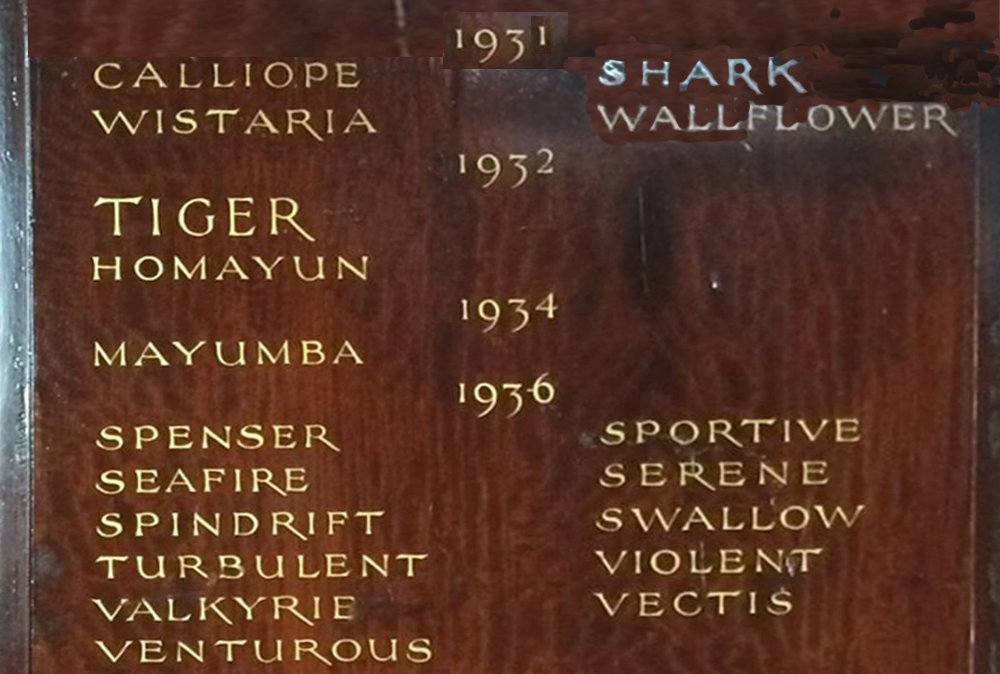
1931
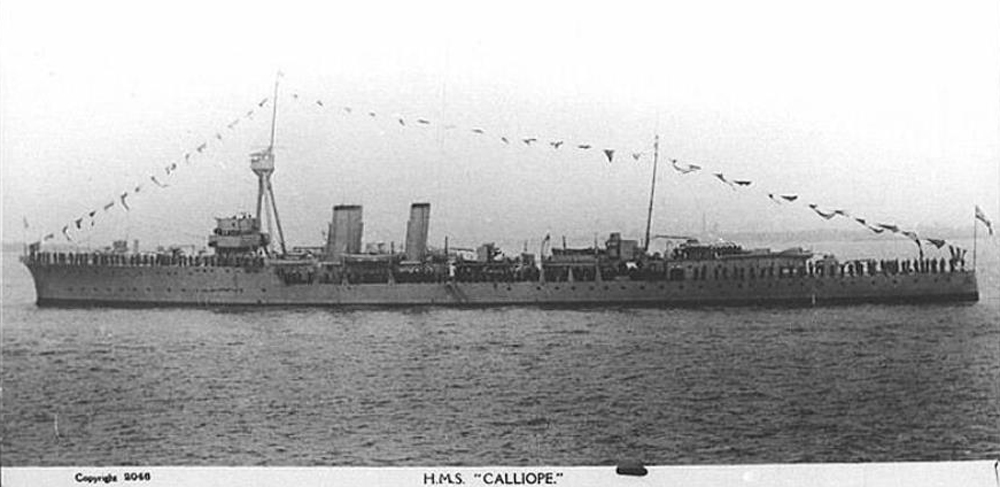 HMS Calliope
HMS Calliope
HMS Calliope – Light Cruiser, Calliope-class.
Built by Chatham Dockyard launched December 1914
Commissioned as flagship 4th Light Cruiser Squadron, Grand Fleet. Suffered severe boiler room fire, 19 March 1916, but repaired in time for Jutland, where she suffered four shell hits.). Helped to sink four trawler minesweepers off Jutland coast in September 1917.
Commissioned March 1919 for 8th LCS, North America and West Indies Station and suffered another engine room fire while off the Azores in October 1919. Repaired at Devonport, November 1919-March 1920 and recommissioned for same service. Returned home December 1920 to refit and paid off at Nore in January 1921. In Nore Reserve October 1921 until recommissioned at Chatham for 2nd CS, Atlantic Fleet in May 1924. Trooping duties in 1925-26 and then paid off into dockyard control at the Nore for refit April 1926. In Nore Reserve but carried out trooping runs in 1927-28 and was SNO’s ship from December 1927. Recommissioned at Chatham September 1928 for 3rd CS, Mediterranean Fleet. Paid off into reserve at Portsmouth January 1930.
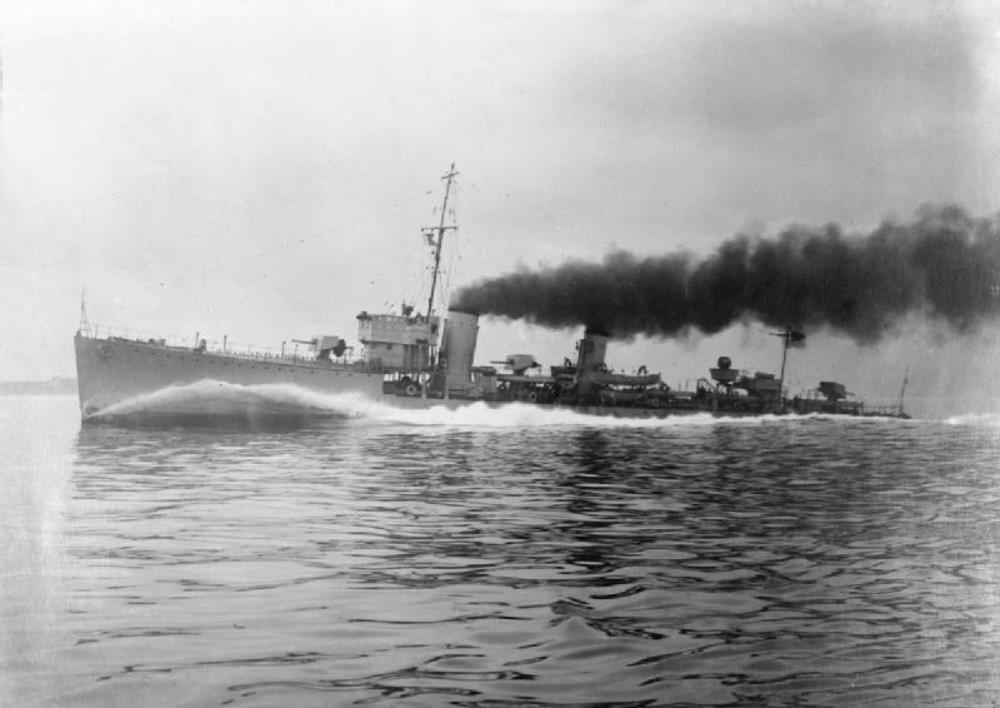 A shark-class destroyer
A shark-class destroyer
HMS Shark – S-class destroyer
The S class of 67 destroyers was ordered for the Royal Navy in 1917. They saw active service in the last months of the First World War and in the Russian and Irish Civil Wars during the early 1920s.
Shark was built by Swan Hunter, launched in September 1917.
wikipedia
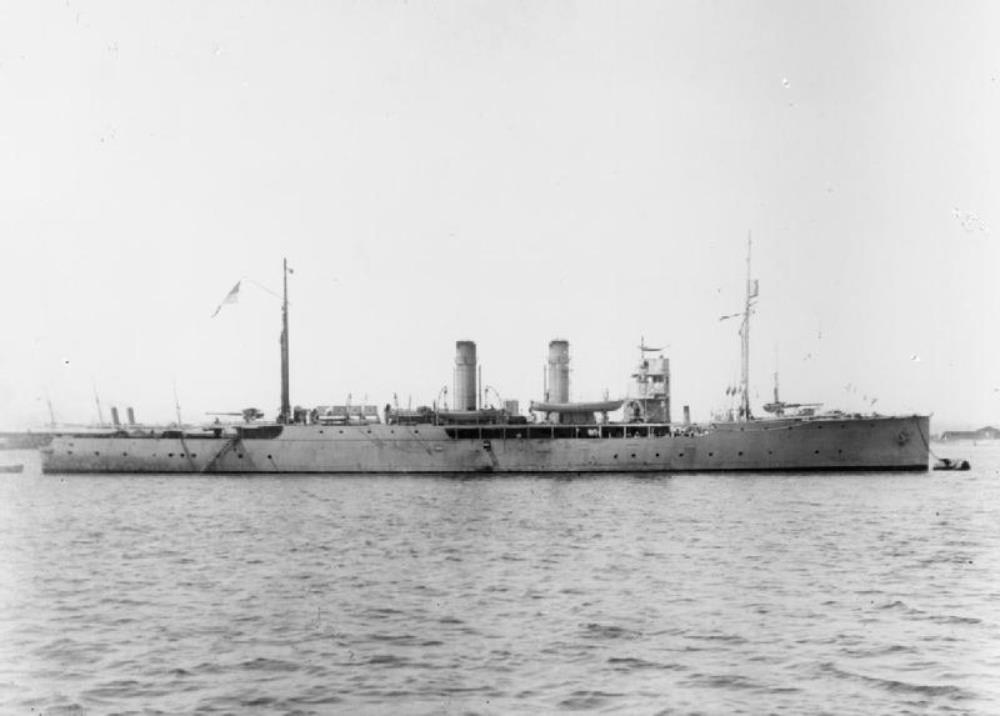
HMS Wistaria – Arabis class of minesweeping sloops (the third, and largest, of the five sub-classes of the “Flower Class”. Built by Irvine’s Shipbuilding and Dry Dock Company, West Hartlepool, launched 7 December 1915.
Arabis-types served in Grand Fleet, at Queenstown, in North Sea, and Mediterranean.
www.naval-history.net
wikipedia
Ships-Log-Books-WW1
HMS Wallflower – Arabis class of minesweeping sloops (the third, and largest, of the five sub-classes of the “Flower Class”. Built by Irvine’s Shipbuilding and Dry Dock Company, West Hartlepool, launched 8 November 1915.
Arabis-types served in Grand Fleet, at Queenstown, in North Sea, and Mediterranean.
www.naval-history.net
wikipedia
1932
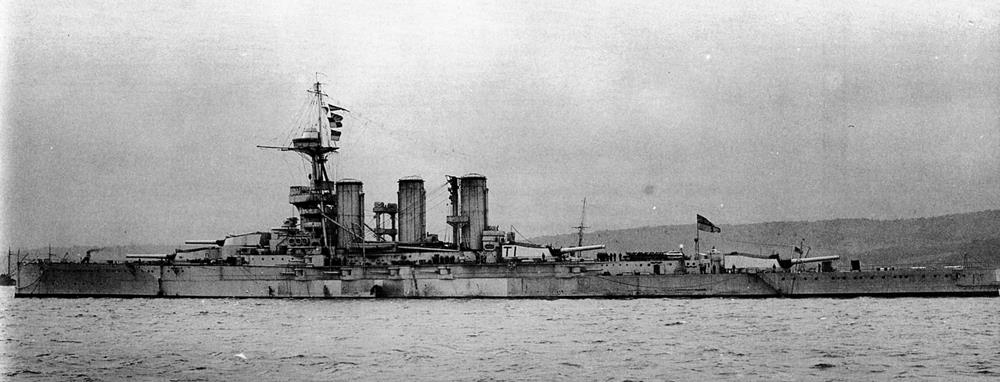 HMS Tiger
HMS Tiger
HMS Tiger was a battlecruiser of the Royal Navy and the eleventh ship to bear that name. Built by John Brown and Company of Clydebank, Scotland, launched in 1913. Tiger was the most heavily armoured battlecruiser of the Royal Navy at the start of the First World War, but was not yet ready for service.
The ship was assigned to the 1st Battlecruiser Squadron (1st BCS) for the duration of the war and participated in the Battle of Dogger Bank in early 1915, though she was still shaking down and did not perform well. Tiger next participated in the Battle of Jutland in 1916, where she was only lightly damaged despite suffering many hits by German shells. Apart from providing distant cover during the Second Battle of Heligoland Bight in 1917, she spent the rest of the war on uneventful patrols in the North Sea.
Tiger was the oldest battlecruiser retained by the Royal Navy after the tonnage limits of the 1922 Washington Naval Treaty. She became a gunnery training ship in 1924 and then joined the Battlecruiser Squadron in 1929 when its flagship, Hood, underwent a lengthy refit. Upon Hood’s return to service in 1931, Tiger was decommissioned.
wikipedia
HMS Homayun This was probably the following ship (the only naval vessel I could find named Homayun)
Boom Defence Vessel.
Originally built in 1895 as “Leopoldville” a Cargo General Steel Screw Steamer, by Sir Raylton Dixon & Co., Middlesbrough, Cleveland Dockyard, for Cie. Belge Maritime du Congo, Antwerp.
Then owned by:
1896 African Steamship Co. Ltd. (Elder, Dempster & Co. Ltd.), London – renamed Biafra
1910 Bombay & Persia S.N. Co. Ltd., Bombay – renamed Homayun
1915 sold to the Admiralty for use as a blockship, then from 1916 used as a boom defence vessel, sold in 1919.
www.teesbuiltships.co.uk
1934
HMS Mayumba – Boom Defence Vessel.
Originally built in 1890 as a Cargo General Steel Screw Steamer, by Sir Raylton Dixon & Co., Middlesbrough, Cleveland Dockyard, for Elder, Dempster & Co., Liverpool.
Then owned by:
1892 African Steamship Co. (Elder, Dempster & Co.), Liverpool
1915 Bidston Shipping Co. Ltd. (C. M. Farrar), London
1915 requisitioned by the Admiralty as a boom defence vessel
1918 purchased by The Admiralty and became oil fuel depot at Killingholme.
www.naval-history.net
www.teesbuiltships.co.uk
RMS Majestic
In 1920, the United Kingdom received the passenger liner SS Bismarck from Germany as a war reparation. She was sold to the White Star Line, later the Cunard White Star Line, in which she served as RMS Majestic.
In 1936, Cunard White Star retired Majestic and sold her to Thos. W Ward for scrapping, but because of legal requirements imposed under the agreement transferring Majestic to the United Kingdom as a war prize, the British government instead took control of Majestic and assigned her to the Royal Navy.
To pay Ward for Majestic, the Royal Navy agreed to transfer 24 old destroyers with a combined scrap value equivalent to that of Majestic.
The Royal Navy converted Majestic to a naval training ship HMS Caledonia. She was based at Rosyth and occupied by 2,000 cadets. In September 1939 she was scheduled for a refit, so the cadets vacated her. On September 29 1939, HMS Caledonia was completely burned out and sank on an even keel in shallow water in the River Forth.
On 15th October 1939, four Luftwaffe waves each consisting of three Junkers 88 bombers attacked shipping in the River Forth in what was the first air raid of World War II. One of the bombers in the fourth wave dropped its bomb load near the burnt out wreck of HMS Caledonia.
In March 1940 she was sold for scrap to T.W. Ward and broken up on the spot down to the waterline. On July 17, 1943 the remainder of the wreck was raised and towed to Inverkeithing, where it was scrapped, providing nearly 40,000 tons of first class steel for the war effort.
1936
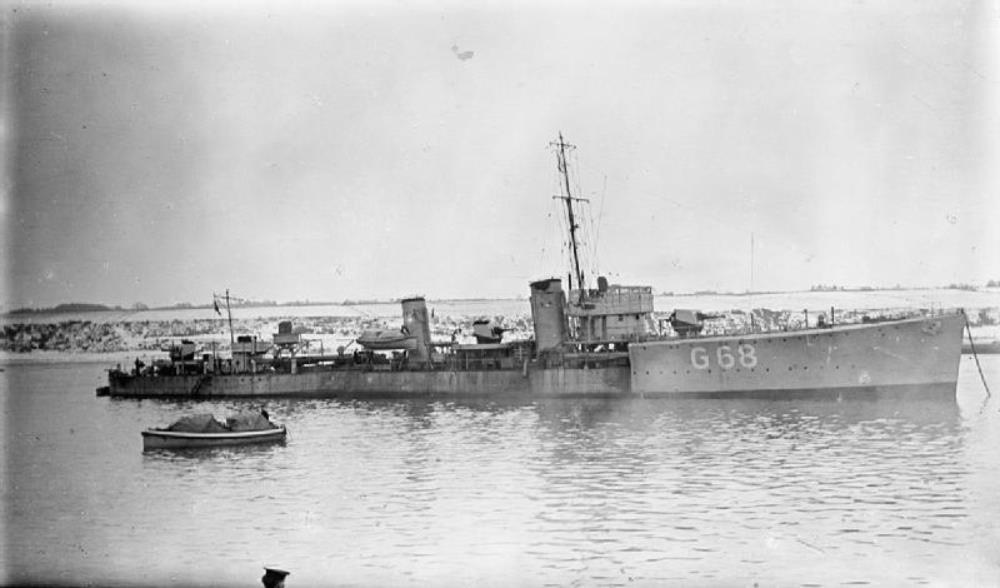
HMS Seafire – S class destroyer, built by John Brown & Company, Clydebank, launched August 1918
After commissioning, Seafire joined the 14th Destroyer Flotilla of the Grand Fleet. Following a post-war reorganisation of the Royal Navy’s destroyer forces, Seafire was listed as part of the 7th Destroyer Flotilla at the beginning of March 1919. Later that month, she, formed part of a force sent to the Baltic Sea as part of the British intervention in the Russian Civil War. On 3 April, Seafire arrived at Liepāja, Latvia, and was then sent to Ventspils, which was threatened by the advancing Bolshevik forces. Seafire set up soup kitchens to help feed the starving population of Ventspils, using up most of her rations, before returning to Liepāja after four days. On 16 April, Baltic Germans staged a Coup d’Etat in Latvia. Seafire, still at Liepāja, prevented the Baltic German forces from capturing the transport Saratov, carrying a load of arms and ammunition, and helped members of the provisional national government to escape to Saratov, which was protected by the Royal Navy
Seafire transferred to the 5th Destroyer Flotilla in October 1919.
She was one of the obsolete destroyers handed over to the shipbreakers Thos W Ward on 14 September 1936 in part-payment for RMS Majestic which the Royal Navy wanted as a training ship
wikipedia
HMS Serene – S class destroyer, built by William Denny, launched 30.11.18 Denny.). Handed over on 14 September 1936 to Ward, Inverkeithing in part-payment for RMS Majestic which the Royal Navy wanted as a training ship.
www.naval-history.net
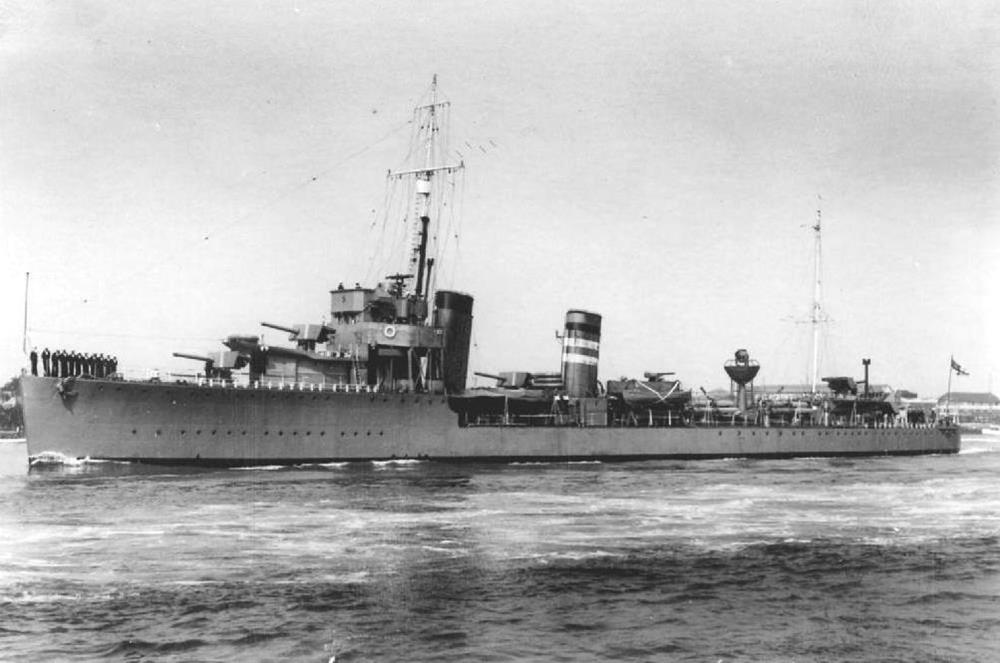 Sister ship – HMS Keppel
Sister ship – HMS Keppel
HMS Spenser – Shakespeare-class destroyer leader, built by Thornycroft Launched 22.9.17.
Spenser joined the 10th Destroyer Flotilla of the Harwich Force in December 1917. On 27 February 1918, Spenser was attacked by a German Zeppelin in the southern part of the North Sea. On 1 August 1918, the Harwich Force took part in an operation against German minesweeping forces. The force would tow six Coastal Motor Boats (CMBs) to the edge of the mined areas in the inner German Bight. From there, the CMBs would proceed over the minefields and search for German minesweepers, which they were to attack with torpedoes. The operation was aborted when they were sighted by a Zeppelin, which dropped bombs that near missed several ships, with Spenser being one of the ships attacked. The operation was repeated on 10–11 August, with Spenser again part of the escort. Air cover was to be provided by flying boats carried on lighters towed behind three of the destroyers, while two more destroyers towed lighters carrying Sopwith Camel fighter aircraft, for use against German Zeppelin airships. When the force reached the minefields, the lack of wind meant that the flying boats could not take off, so the CMBs continued on unescorted, and were subject to sustained attacks by German aircraft, which resulted in three of the CMBs being sunk and the other three being interned in the Netherlands. Meanwhile, the Harwich Force, waiting for the CMBs to return, encountered the German airship L53, and a Camel took off from a lighter towed behind the destroyer Redoubt and shot down L53.] Spencer remained a member of the 10th Flotilla at the end of the war on 11 November 1918.
On 21 November and 1 December 1918, Spenser escorted German U-Boats to Harwich so they could surrender. The Royal Navy’s destroyer forces were reorganised after the end of the war, with joining the newly established 2nd Destroyer Flotilla, based at Rosyth, and serving as flagship for the Flotilla’s Captain, in March 1919.
In August 1919, the 2nd Destroyer Flotilla, led by Spenser, was deployed to the Baltic Sea as part of the British operations in the Baltic during the Russian Civil War, relieving the 1st Destroyer Flotilla. On the night of 17/18 August, the 2nd Flotilla, including Spenser escorted seven CMBs on a raid on the Red Fleet anchorage at Kronstadt. The CMBs sank the submarine depot ship Pamiat Azova and damaged the battleship Andrei Pervozvanny at the cost of three CMBs sunk. Regular duties of the 2nd Flotilla and Spenser included patrols and shore bombardment against Bolshevik forces. On 27 October, Spenser and nine other ships took part in a bombardment of the Krasnaya Gorka fort, in support of an Estonian offensive against Petrograd. Despite the support from the Royal Navy, the Bolsheviks kept control of the fort and the Estonian offensive was stopped, and the flotilla returned to Britain.
Spenser was again deployed to the Baltic in June 1920 and in September–October 1921, but by this time hostilities between Britain and the Bolshevik forces had ended.
In September 1924, Spenser joined the 3rd Destroyer Flotilla of the Mediterranean Fleet, where she served until May 1925.
After service at home and in the Mediterranean, she went into reserve in 1925 and was handed over on 29th September 1936 to Ward, Inverkeithing in part payment for RMS Majestic which the Royal Navy wanted as a training ship.
wikipedia
www.naval-history.net
HMS Spindrift – S class destroyer, built by Fairfield Shipbuilding and Engineering Company, Govan. Launched 30 December 1918, completed April 1919
http://www.dreadnoughtproject.org/tfs/index.php/H.M.S._Spindrift_(1918)
HMS Sportive – S class destroyer, built by Swan Hunter, launched 19.September 1918, completed, December 1918
She joined the Mediterranean Fleet, arriving in Sportive arrived in Alexandria in October 1919, then sailed to the Black Sea, in company with Marlborough, Speedy and Tobago, passing through Constantinople on the 29th in.[9]
She arrived again at Constantinople on 13 February, 1920, leaving on the 15th for Mersina.
She was recommissioned at Malta in June, 1920, then reduced to Reserve Complement in June, 1924. Godfrey Ratcliffe Chambers took command of Sportive for passage to Rosyth in early 1928. Once there, she went into Maintenance Reserve on 30 March, 1928.
She was finally handed over in September 1936 to Ward. Inverkeithing in part payment for RMS Majestic which the Royal Navy wanted as a training ship.
www.dreadnoughtproject.org
www.naval-history.net
HMS Swallow – S class destroyer, built by Scotts Shipbuilding and Engineering Company, Greenock, launched 1st August 1918.
She joined the Mediterranean Fleet, and was re-commissioned at Malta on 13 September, 1920, then re-commissioned at Chatham with 2/5ths crew on 4 December, 1923.[7]
Paid off into Reserve at Chatham on 29 January, 1926.
Paid off into Maintenance Reserve at Rosyth on 30 March, 1928.
Handed over in September 1936 to Ward. Inverkeithing in part payment for RMS Majestic which the Royal Navy wanted as a training ship.
www.dreadnoughtproject.org
www.naval-history.net
HMS Turbulent – S class destroyer, built by Hawthorn Leslie, Tyneside launched 29th May 1918
Turbulent was reduced to Reserve at Chatham on 24 August, 1920.
She reduced to Reserve at the Nore on 1 October, 1925.[7]
She was recommissioned at Chatham on 29 August, 1927 and proceeded to Rosyth to join other destroyers in Reserve.
Handed over 25.8.36 to Ward. Inverkeithing in part payment for RMS Majestic which the Royal Navy wanted as a training ship.
www.dreadnoughtproject.org
www.naval-history.net
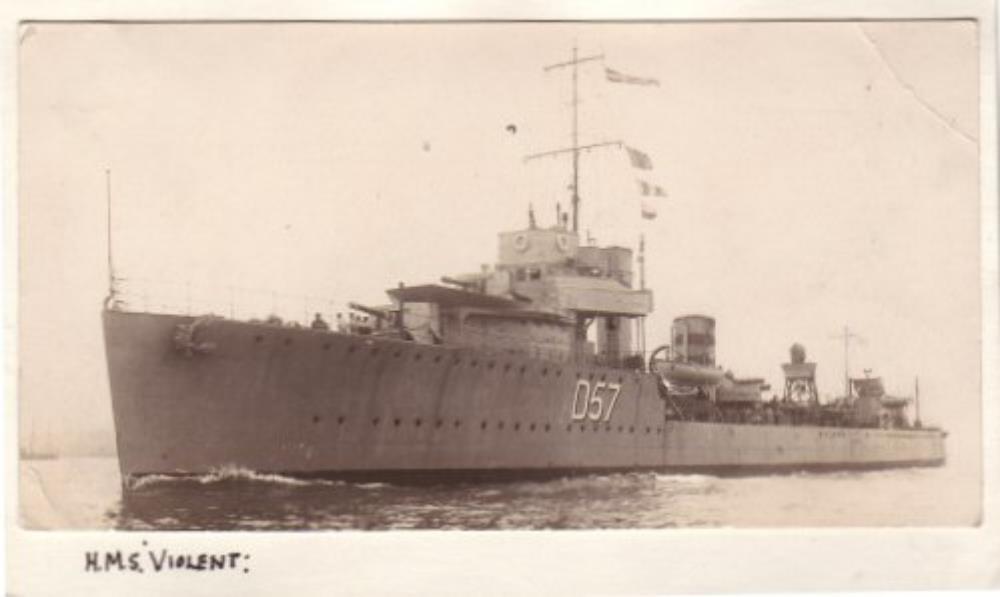 HMS Violent
HMS Violent 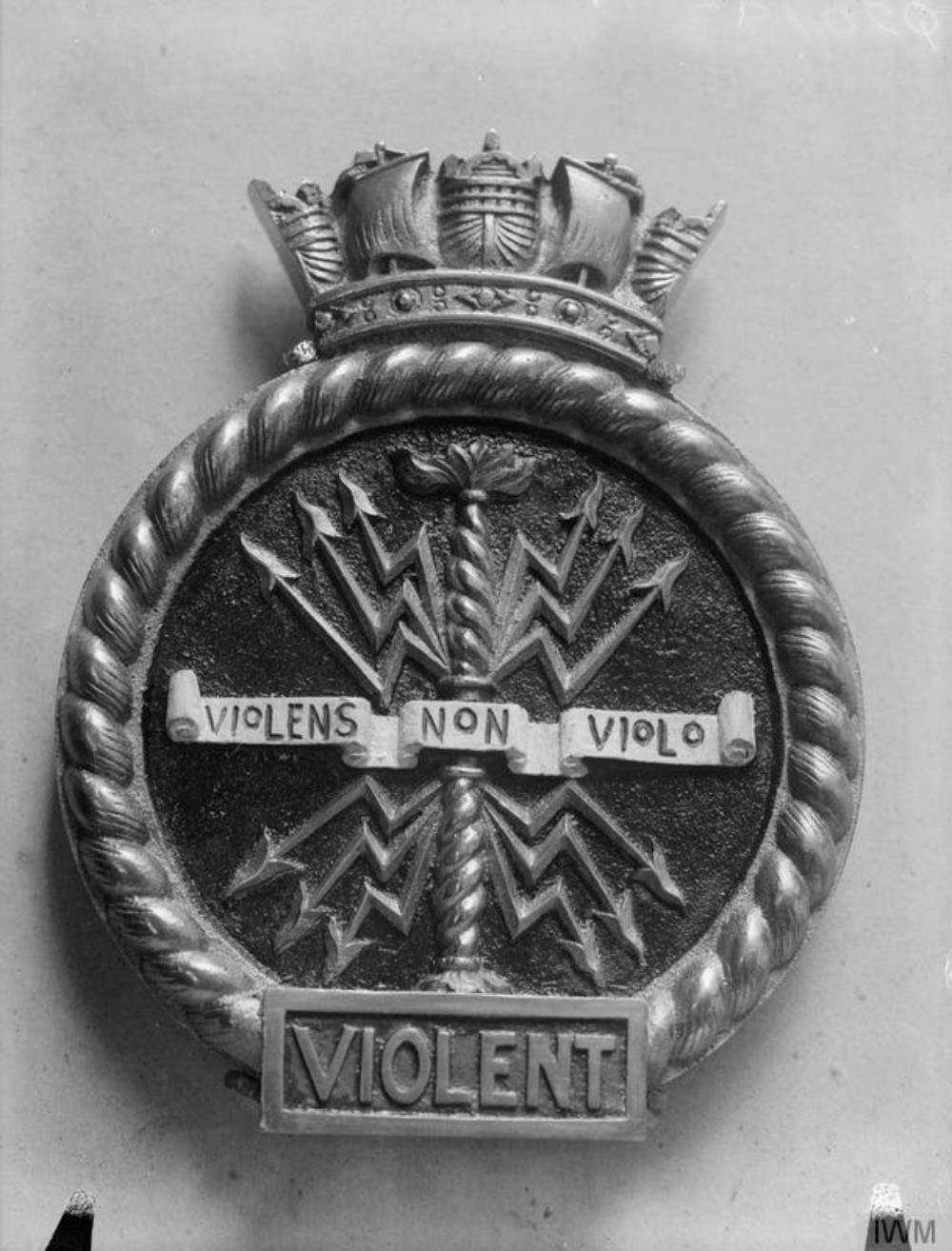 HMS Violent ship badge
HMS Violent ship badge
HMS Violent – V-class destroyer, built by Swan Hunter, Tyne and Wear, launched 1st September 1917
Violent was assigned to the Grand Fleet or Harwich Force for the rest of World War I.
On 19 July 1918, she participated in history’s first attack by aircraft launched from the flight deck of an aircraft carrier, when she operated in the North Sea in support of a strike by Royal Air Force Sopwith Camel fighters from the aircraft carrier HMS Furious against the Imperial German Navy Zeppelin dirigible sheds at Tondern, in what became known as the Tondern raid.
In 1921, Violent joined the light cruisers HMS Caledon, Castor, Cordelia, and Curacoa and the destroyers HMS Vanquisher, Vectis, Venetia, Viceroy, Viscount, Winchelsea, and Wolfhound in a Baltic cruise, departing the United Kingdom on 31 August 1921, crossing the North Sea and transiting the Kaiser Wilhelm Canal to enter the Baltic. The ships called at Danzig in the Free City of Danzig; Memel in the Klaipėda Region; Liepāja, Latvia; and Riga, Latvia. The ships sighted a naval mine at the entrance to the harbor as they approached Tallinn, Estonia, on 17 September 1921, and Violent, ordered to sink it, detonated it with gunfire while the other ships waited to proceed. The ships then pulled into Tallinn for a port call and went on to visit Helsinki, Finland; Stockholm, Sweden; Copenhagen, Denmark; Gothenburg, Sweden; and Kristiania, Norway, before crossing the North Sea and ending the voyage at Port Edgar, Scotland, on 15 October 1921.
She was handed over on 8th March 1937 to Ward, Inverkeithing in part payment for RMS Majestic which the Royal Navy wanted as a training ship.
wikipedia
www.naval-history.net
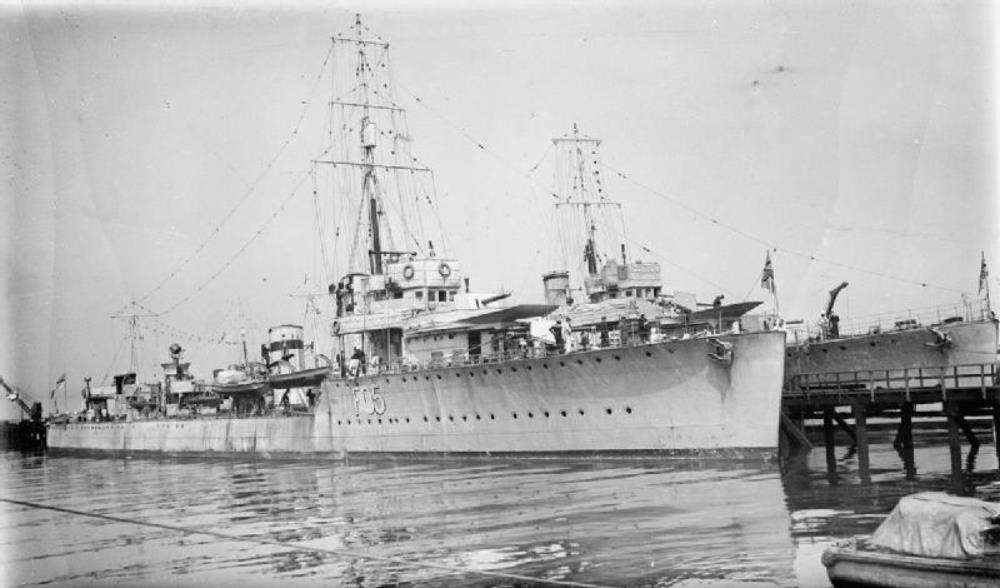
HMS Valkyrie – V-class flotilla leader, built by William Denny, Dumbarton, launched 13th March 1917
After commissioning Valkyrie joined the 10th Destroyer Flotilla as leader, forming part of the Harwich Force, and carrying out offensive sweeps and convoy escort operations.
On 22 December 1917, Valkyrie was part of the escort for a convoy to the Netherlands when she struck a mine. Three more destroyers of the 10th Flotilla, Torrent, Surprise and Tornado, were sunk by mines on the next day. Valkyrie was under repair at Chatham Dockyard until July 1918.
After repair, Valkyrie joined the 13th Destroyer Flotilla based at Rosyth Dockyard led by the light cruiser Champion.
In November 1918, following the Armistice, the 13th Destroyer Flotilla, including Valkyrie, was sent to the Baltic sea as part of the British intervention. The 13th Flotilla was relieved in January 1919.
In 1919 she was reassigned to the 3rd Destroyer Flotilla.
In 1921, the destroyer force was again reorganised around smaller flotillas comprising eight destroyers and a leader. Valkyrie was assigned to the 9th Destroyer Flotilla which were laid up at Rosyth Dockyard with skeleton crews.
Handed over 24th August 1936 to Ward, Inverkeithing in part payment for RMS Majestic which the Royal Navy wanted as a training ship.
wikipedia
www.naval-history.net
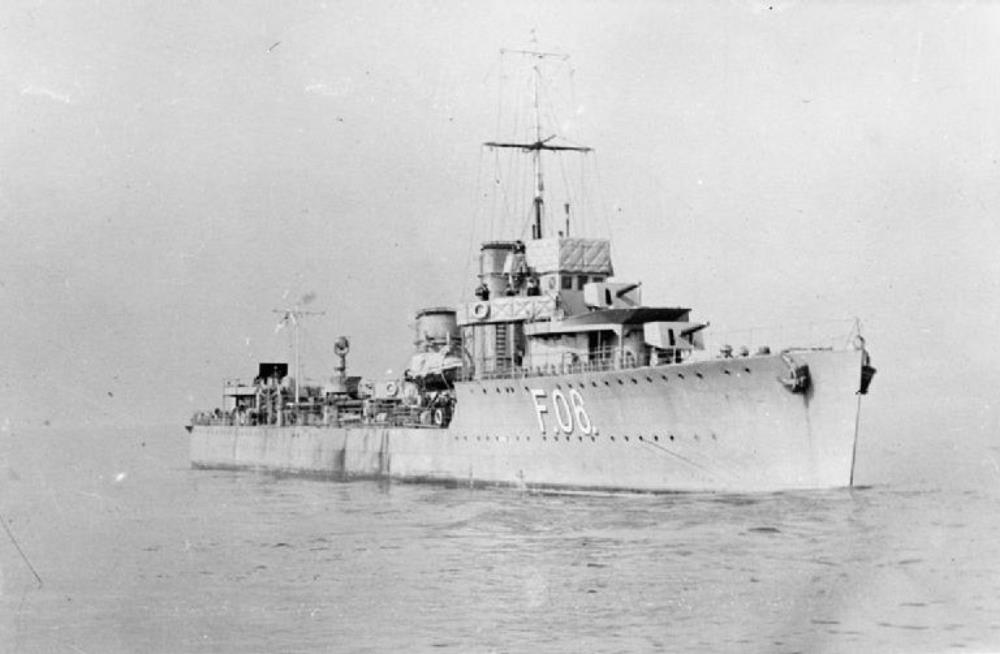
HMS Vectis – V-class destroyer, built by J. Samuel White, Cowes, Isle of Wight launched 4th September 1917, completed 5 December 1917.
In early June 1918, Vectis conducted towing trials with the NS-class airship N.S.3 to see if an airship which ran out of fuel or suffered a mechanical breakdown could be towed at speed by a ship at sea. Trials were successful, with Vectis reaching nearly 20 knots with N.S.3 in tow. Before the final run, N.S.3 landed on the sea to exchange 2 officers from HMS Vectis, with 2 of her own crew.
After the armistice Vectis was incorporated into a new 3rd Destroyer Division, 2nd Destroyer Flotilla, in the spring of 1919. She took in the 1919 British campaign in the Baltic Sea against Bolshevik forces during the Russian Civil War.
Vectis was among the ships which accompanied the battlecruisers HMS Hood and HMS Tiger during their visit to Scandinavian ports in June 1920. During the voyage, she and the destroyer HMS Vega tested the Royal Navy’s High Speed Mine Sweep, which the British Admiralty hoped to use in the shallow waters of the Baltic in the event of a war with Bolshevik Russia (soon to become the Soviet Union). In a blow to the Admiralty’s plans, both destroyers lost their minesweeping apparatus, demonstrating the High Speed Mine Sweep to be impractical in shallow water.
On 21 January 1925, Vectis took part with Royal Air Force bombers, the light cruisers Caledon, HMS Calliope, HMS Carysfort, and Curacoa, the battlecruisers Hood and HMS Repulse, and the battleships HMS Ramillies, HMS Resolution, HMS Revenge, HMS Royal Oak, and HMS Royal Sovereign in sinking the decommissioned battleship HMS Monarch as a target 50 nautical miles south of the Scilly Isles, firing her 4-inch (102-mm) guns at Monarch.
She was handed over on 25th August 1936 to Ward, Inverkeithing in part payment for RMS Majestic which the Royal Navy wanted as a training ship.
wikipedia
www.naval-history.net
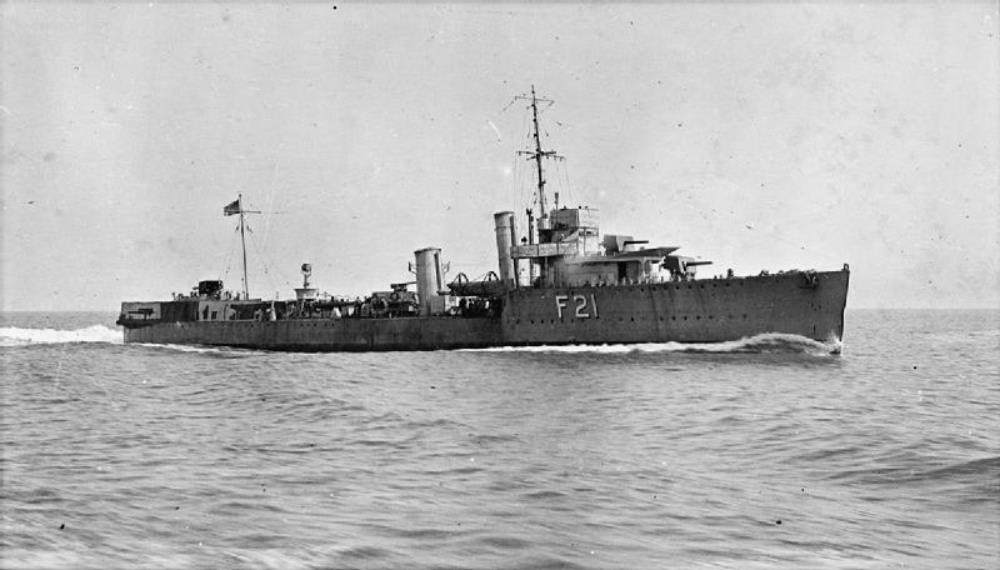
HMS Venturous – V-class destroyer, built by William Denny, Dumbarton, launched 21st September 1917 Fitted to carry 60 mines.
During World War I, Venturous took part in the first deployment of operational magnetic bottom mines when she joined the destroyers HMS Abdiel, Tarpon, Telemachus, Vanoc, and Vanquisher, escorted by eight other destroyers, in laying 234 Sinker mines in the North Sea off the coast of Flanders, Belgium, about eight nautical miles north of Dunkirk, France.
She also participated with Abdiel, Tarpon, Telemachus, and Vanquisher in the second operation to lay Sinker mines on 22 August 1918, in the North Sea off Flanders about 17 nautical miles north of Zeebrugge, Belgium, supported by Royal Air Force aircraft which patrolled to prevent German aerial observation of the operation.
As the result of a reorganization of Royal Navy destroyer flotillas in 1921, Venturous became part of the 9th Destroyer Flotilla along with the destroyer leaders HMS Douglas, Valentine, and Valkyrie and the destroyers Vanessa, Verdun, Vesper, Vivien, and Whitley. The entire flotilla was transferred to the Reserve Fleet on 4 April 1922 and laid up at Rosyth, Scotland, with reduced crews, but it was recommissioned on 8 April 1925 and renumbered as the 7th Destroyer Flotilla.
She was Handed over on 24th August 1936 to Ward, Inverkeithing in part payment for RMS Majestic which the Royal Navy wanted as a training ship.
wikipedia
www.naval-history.net
In 1918, Admiral Beatty recognized the contribution of the Immingham-based mine-layers, by including them in the pageant at the Surrender of the German High Seas Fleet.
On board Venturous was W.B. Adam, who spent his gap year between school and university as a midshipman. He kept a diary of his exploits. Naval Interlude Extracts from his diary covers the surrender.
| < 1922-1929 | Δ Index | 1937-1946 > |